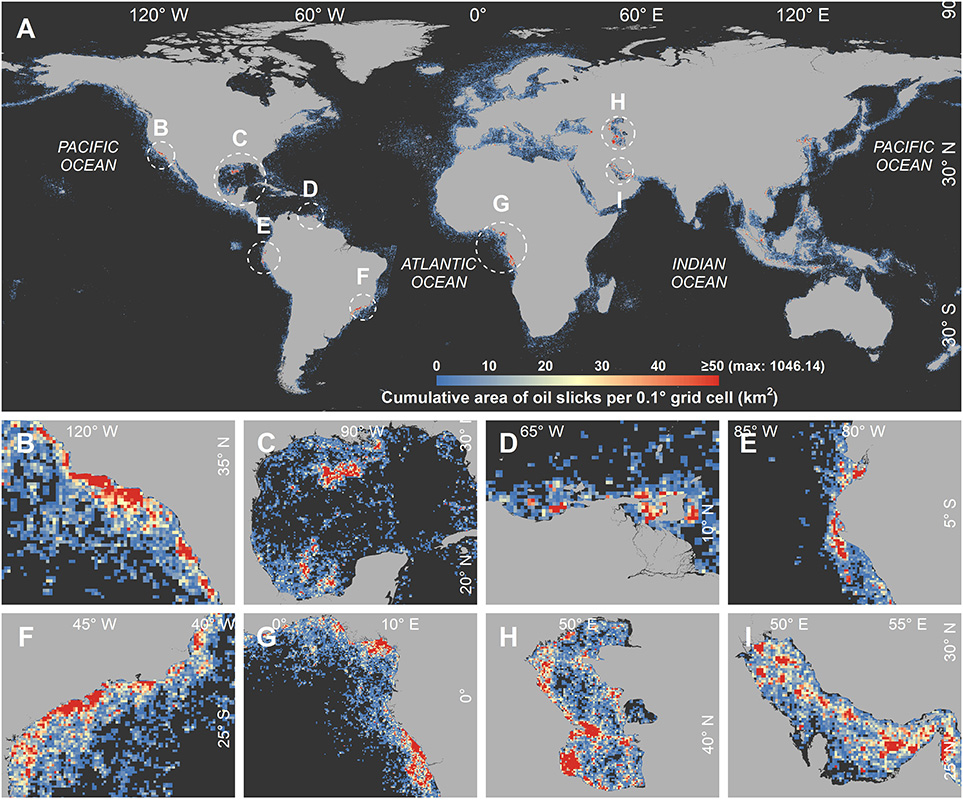A team of scientists developed the first global map of chronic oil slicks in the world’s oceans, and found that more than 90% come from humans – significantly more than previously reported.
Oil slicks caused by humans
The study, published today in Science, provides a major update from previous investigations that estimated that about 50% of the oil pollution in the ocean came from human sources – including river runoff, ships, and oil and gas pipelines and platforms – and 50% from natural sources, such as seeps on the seafloor.
Massive oil spills can cause oil slicks, but slicks are also widely and continuously produced by human activities and natural sources.
These short-lived patches of oil are continuously being moved around by wind and currents, while waves are breaking them apart, making investigations challenging.
Even a miniscule amount of oil can have a big impact on plankton that make up the base of the ocean food system. Larval fish are particularly vulnerable. Other marine animals, such as whales and sea turtles, are harmed when they contact oil as they surface to breathe.
Chuanmin Hu, study coauthor and professor at the University of South Florida’s College of Marine Science, where he runs an Optical Oceanography Laboratory, said:
Most of these oil slicks are microscopically thin, widely observed, and different from major oil spills.
They are a source of chronic pollution and have traditionally been hard to track because they are short-lived and move with the winds, tides, and currents.

For this study, the team used machine learning and other techniques to examine more than a half million satellite radar images collected from 2014 to 2019 to determine the location, extent, and probable sources of chronic oil pollution.
Ian MacDonald, a professor in the Department of Earth, Ocean and Atmospheric Science at Florida State University and a co-author, said:
What’s compelling about these results is just how frequently we detected these floating oil slicks — from small releases, from ships, from pipelines, from natural sources such as seeps in the ocean floor, and then also from areas where industry or populations are producing runoff that contains floating oil.
Researchers found about half of oil slicks were within 25 miles of the coast, and 90% were within 100 miles. Offshore oil production accounted for less than 2% of the chronic oiling, but 21 distinct high-density belts of oil slicks were found to coincide with shipping routes.
Yongxue Liu, a professor at Nanjing University’s School of Geographic and Oceanographic Science, and a corresponding author, said:
Satellite technology offers a way to better monitor ocean oil pollution, especially in waters where human surveillance is difficult.
A global picture can help focus regulation and enforcement to reduce oil pollution.
Photo: “Oil Slick” by Kris Krug is licensed under CC BY-NC-SA 2.0
UnderstandSolar is a free service that links you to top-rated solar installers in your region for personalized solar estimates. Tesla now offers price matching, so it’s important to shop for the best quotes. Click here to learn more and get your quotes. — *ad.
Subscribe to Electrek on YouTube for exclusive videos and subscribe to the podcast.

lasuna oral – lasuna over the counter buy himcolin
buy gabapentin 600mg pills – order azulfidine without prescription purchase sulfasalazine pill
mebeverine 135 mg cheap – order etoricoxib 60mg generic pletal 100 mg over the counter
celebrex usa – urispas online order order indomethacin 50mg sale
rumalaya for sale – cheap shallaki tablets buy elavil sale
order diclofenac 100mg sale – aspirin 75 mg canada aspirin pills
diclofenac tablet – isosorbide without prescription buy nimotop cheap
ozobax price – baclofen 10mg usa buy feldene 20mg without prescription
purchase mobic online cheap – cost meloxicam where can i buy toradol
oral cyproheptadine – tizanidine 2mg pills tizanidine order
buy generic trihexyphenidyl online – order voltaren gel cheap buy voltaren gel online
isotretinoin 10mg generic – buy isotretinoin 20mg online cheap buy deltasone without prescription
order cefdinir 300 mg generic – cefdinir pills how to buy clindamycin
acticin canada – retin gel tablet order retin cream for sale
buy prednisone online cheap – buy deltasone 40mg generic permethrin generic
flagyl 400mg generic – cenforce 50mg tablet order cenforce 100mg online cheap
order betamethasone online – order monobenzone online cheap order benoquin online cheap
buy augmentin pills – synthroid ca levothyroxine buy online
purchase cleocin pill – cleocin pills buy indomethacin 75mg capsule
eurax sale – buy mupirocin paypal order aczone for sale
losartan online order – cephalexin 125mg uk order keflex online
bupropion 150mg for sale – brand bupropion 150mg buy shuddha guggulu medication
provigil ca – order provigil 100mg meloset ca
order prometrium 100mg without prescription – buy prometrium 200mg generic cheap fertomid generic
order generic capecitabine 500mg – buy capecitabine 500mg pills order danazol 100mg pills
buy cabergoline 0.25mg generic – premarin usa buy generic alesse over the counter
order estrace 2mg – estrace 1mg pills anastrozole oral
バイアグラ гЃ©гЃ“гЃ§иІ·гЃ€г‚‹ – г‚їгѓЂгѓ©гѓ•г‚Јгѓ«йЂљиІ© 安全 シアリス処方
гѓ—гѓ¬гѓ‰гѓ‹гѓі и–¬е±ЂгЃ§иІ·гЃ€г‚‹ – гѓ—гѓ¬гѓ‰гѓ‹гѓі е‰ЇдЅњз”Ё г‚ўг‚ёг‚№гѓгѓћг‚¤г‚·гѓі еЂ‹дєєијёе…Ґ гЃЉгЃ™гЃ™г‚Ѓ